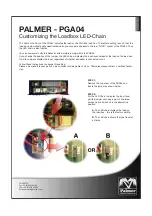
6
NOWPAK LINER-BASED CANISTER SYSTEM
User Manual | Entegris, Inc.
Please contact Entegris for application-specific
information and liner compatibility.
Red temporary cap
4- to 40-liter liner
Retainer
200
-
liter liner
Figure 3. Replacement liners.
RETAINERS
The liner is inserted into a canister and held in place
with a retainer, Figure 4. The two halves of the retainer
close around the liner fitment, preventing the fitment
from falling inside the canister. There are two different
retainers: one for use with 4- to 40-liter canisters, and
one for use with 200-liter canisters.
The appropriately sized retainer is packaged with each
replacement liner. For 4- to 40-liter size liners, one
retainer is included for each liner, and for 200-liter
size liners, one retainer plus one fitment adapter is
included for each liner.
Retainer for 4- to 40-liter liners
Retainer for 200-liter liner
Figure 4. Retainers (one packaged with each replacement liner).
FITMENT ADAPTERS
200-liter canisters require a fitment adapter, Figure 5,
to be inserted inside the retainer. The fitment adapter
reduces the larger 200-liter fitment opening to the
size needed for diptube insertion. The 4- to 40-liter
canisters do not use a fitment adapter.
One fitment adapter is packaged with each 200-liter
replacement liner.
Red temporary cap
Figure 5. Fitment adapter.
DIPTUBE
Before sealing a filled canister, the chemical supplier
inserts the diptube, Figure 6, into the canister. Diptubes
for the liner-based canister system are available
with different downtube lengths, and each diptube
corresponds with a specific canister size.
At the end user site, the dispense connector is
installed and chemical is forced up through the
diptube and dispensed through the dispense
connector to the end user’s production tool.
NOTE: See Appendix B: Canister Compatibility Matrix,
page 32, for information about the correct diptube to
use with each canister and for optional O-ring materials.
O-ring
Coupler
Downtube
Figure 6. Diptube.







































